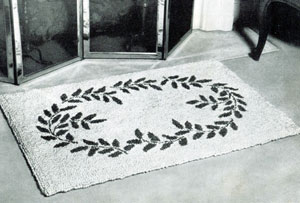Newly Added Crochet Patterns
- Afghans | Fashions in Wool | Styled by Hilde Volume 92
- Crochet for Tables | Book No. 202 | The Spool Cotton Company
- Elegant Throw Pattern #692
- Hexagon Afghan Pattern #689
- Potholder Pattern #9430
- Potholder Pattern #9417
- Star Tablecloth Book | Book 28 | American Thread Company
- New Table Talk | Book No. 157 | The Spool Cotton Company
- Tables of Tomorrow | Book No. 135 | The Spool Cotton Company
- New Table Settings | Book No. 95 | The Spool Cotton Company
- Lilac Time Tablecloth Pattern #7651
- Muffin Cozy Pattern #7629
Hooked Rugs

American women consider Hooked Hugs to be among the most beautiful and the most popular of all homecraft rugs. Hooked Rugs add charm and distinction to any home. They are long wearing, and many lovely patterns and yarn colors are available. Many people find Hooked Rugs are most effective in the simpler patterns.
For equipment you need only a frame and a rug needle. Made with LUSTERSPUN YARN, Hooked Rugs are inexpensive, yet they have the luster and beauty of rugs costing many times more.
Ready made frames are available at low cost from most Art Needlework Departments in retail stores. If, however, you are unable to locate one, a usable frame can be made from four strips of soft wood. These strips should be approximately two inches wide and ¾" thick. Any frame above 24 inches square can be used, but a frame approximately 30" by 40" is a more convenient size. If you use a smaller frame, you will tack on only a portion of the pattern at a time, and then move the pattern as work progresses.
INSTRUCTIONS: Stretch the rug foundation—stencilled side up—tightly over the top of a wood frame. Use thumb tacks every 2" or so, and be sure the foundation is TIGHT and SQUARE on the frame so the borders will be straight.
The "up" side on which you work will eventually be the "wrong" side of the rug. The face or pile of the rug is built up on the '"under" side of the pattern, as you work. No knots are tied. The yarn is cut from the needle on the "work" side when the end is reached, and a new strand of yarn inserted in the needle to start again. Leave two or three inches of yarn loose, to be clipped off later. To thread rug needle, follow instructions supplied with your needle. To INSURE A STRAIGHT OUTER EDGE, put in the outside rows first, with the gauge set for a shorter pile in the first two outside rows. The rest of the rug should be made with a slightly higher gauge for a higher pile. This method of procedure will give you a straight outline on the sides and yet the edge of the rug will be nicely rounded.
To start work, punch the rug needle into the pattern until the GAUGE touches the cloth; raise the needle to surface of the cloth and make another stitch but do NOT raise the needle ABOVE the cloth between one stitch and another—just lift the needle far enough to slide over to the next stitch. In other words, "drag" it across the surface of the cloth rather than raising it above the surface. Work the needle straight up and down, and see that the yarn feeds freely. The open side of the needle should always face ahead of the work. Keep material stretched tightly on the frame for best results. Do not punch rows of stitches too close, to avoid having pattern become TOO fully packed with yarn. Be careful, however, not to make rows too far apart. A little experience will teach you the proper distance between rows.
After your rug is completed, check for any minor imperfections before removing from frame. These imperfections sometimes appear as slight open spots, which can be corrected by filling in with stitches where necessary.
Remove rug from frame, fold edges under, and hem; coarse linen thread or carpet thread is recommended.
WASHING INSTRUCTIONS: Wash with ordinary care and rinse thoroughly, roll rug in bath towel to remove excess water. Place rug in sun and breeze for quick drying if possible. Be sure the rug is completely dry before using again.
Other great patterns from Rugs, Sweaters, Pot Holders, Lamp Shades, Book No. 107.
Knitting Patterns
Cable Knit Sleeveless Sweater
Slipover Sweater
Child's Beret
Checker Scarf
Mittens
Crochet Patterns
Hexagon Rug
Rectangle Rug I
Rectangle Rug II
Oval Rug
Circle Rug
Pinwheel Potholder
Square Potholder
Table Pads
Place Mats










